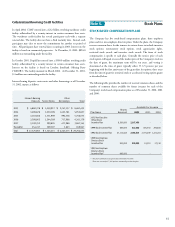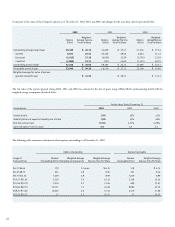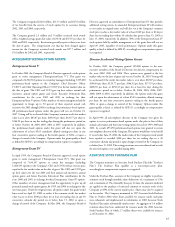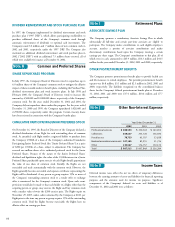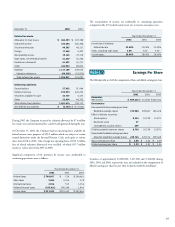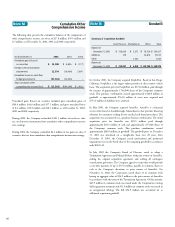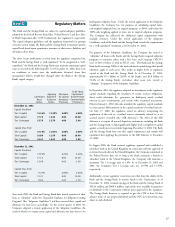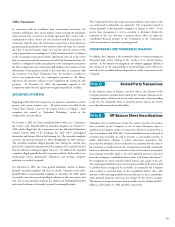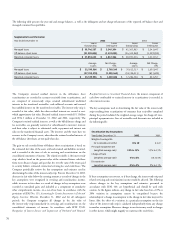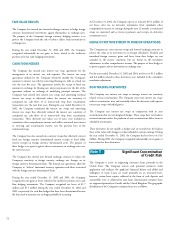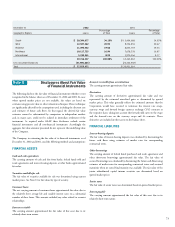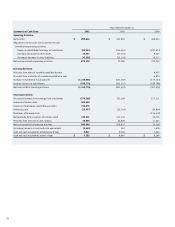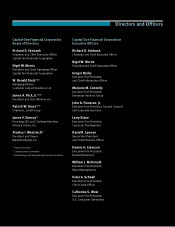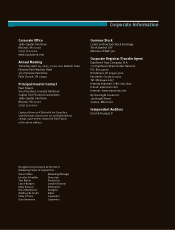Capital One 2002 Annual Report Download - page 73
Download and view the complete annual report
Please find page 73 of the 2002 Capital One annual report below. You can navigate through the pages in the report by either clicking on the pages listed below, or by using the keyword search tool below to find specific information within the annual report.
71
Securitization Key Assumptions and Sensitivities
As of December 31 2002 2001
Interest-only strip $ 236,398 $269,527
Weighted average life for receivables (months) 99
Principal repayment rate (weighted average rate) 14% 13%
Impact on fair value of 10% adverse change $ (15,353) $ (12,496)
Impact on fair value of 20% adverse change (27,252) (23,652)
Charge-off rate (weighted average rate) 6% 6%
Impact on fair value of 10% adverse change $ (46,083) $ (50,844)
Impact on fair value of 20% adverse change (92,167) (100,854)
Discount rate (weighted average rate) 8% 9%
Impact on fair value of 10% adverse change $ (1,387) $ (1,889)
Impact on fair value of 20% adverse change (2,733) (3,706)
Static pool credit losses are calculated by summing the actual and projected
future credit losses and dividing them by the original balance of each pool of
assets. Due to the short-term revolving nature of the consumer loan
receivables, the weighted average percentage of static pool credit losses is not
considered materially different from the assumed charge-off rates used to
determine the fair value of the retained interests.
The Company acts as a servicing agent and receives contractual servicing fees
of approximately 2% of the investor principal outstanding. The servicing
revenues associated with transferred receivables adequately compensate the
Company for servicing the accounts. Accordingly, no material servicing asset
or liability has been recorded.
Securitization Cash Flows
Year Ended December 31 2002 2001
Proceeds from new securitizations $ 12,533,886 $ 11,915,990
Collections reinvested in revolving-
period securitizations 45,740,377 31,115,306
Repurchases of accounts from the trust - 1,579,455
Servicing fees received 490,935 330,350
Cash flows received on retained interests(1) 3,033,951 2,498,970
(1) Includes all cash receipts of excess spread and other payments
(excluding servicing fees) from the Trust to the Company.
For the years ended December 31, 2002 and 2001, the Company recognized
$30.1 million and $68.1 million, respectively, in gains related to new
securitization transactions accounted for as sales, net of transaction costs.
These gains are included in servicing and securitizations income.
Note S Derivative Instruments
and Hedging Activities
The Company maintains a risk management strategy that incorporates the
use of derivative instruments to minimize significant unplanned fluctuations
in earnings caused by interest rate and foreign exchange rate volatility. The
Company’s goal is to manage sensitivity to changes in rates by modifying the
repricing or maturity characteristics of certain balance sheet assets and
liabilities, thereby limiting the impact on earnings. By using derivative
instruments, the Company is exposed to credit and market risk. If the
counterparty fails to perform, credit risk is equal to the extent of the fair value
gain in a derivative. When the fair value of a derivative contract is positive,
this generally indicates that the counterparty owes the Company, and,
therefore, creates a repayment risk for the Company. When the fair value of a
derivative contract is negative, the Company owes the counterparty, and
therefore, has no repayment risk. The Company minimizes the credit (or
repayment) risk in derivative instruments by entering into transactions with
high-quality counterparties that are reviewed periodically by the Company’s
credit committee. The Company also maintains a policy of requiring that all
derivative contracts be governed by an International Swaps and Derivatives
Association Master Agreement; depending on the nature of the derivative
transaction, bilateral collateral agreements may be required as well.
Market risk is the adverse effect that a change in interest rates, currency, or
implied volatility rates has on the value of a financial instrument. The
Company manages the market risk associated with interest rate and foreign
exchange contracts by establishing and monitoring limits as to the types and
degree of risk that may be undertaken.
The Company periodically uses interest rate swaps as part of its interest rate
risk management strategy. Interest rate swaps generally involve the exchange
of fixed and variable rate interest payments between two parties, based on a
common notional principal amount and maturity date. As a result of interest
rate fluctuations, hedged assets and liabilities will appreciate or depreciate in
market value. To the extent that there is a high degree of correlation between
the hedged asset or liability and the derivative instrument, the income or loss
generated will generally offset the effect of this unrealized appreciation or
depreciation.
The Company’s foreign currency denominated assets and liabilities expose it
to foreign currency exchange risk. The Company enters into various foreign
exchange derivative contracts for managing foreign currency exchange risk.
Changes in the fair value of the derivative instrument effectively offset the
related foreign exchange gains or losses on the items to which they are
designated.
The Company has non-trading derivatives that do not qualify as hedges.
These derivatives are carried at fair value and changes in value are included in
current earnings.
The asset/liability management committee, as part of that committee’s
oversight of the Company’s asset/liability and treasury functions, monitors
the Company’s derivative activities. The Company’s asset/liability
management committee is responsible for approving hedging strategies. The
resulting strategies are then incorporated into the Company’s overall interest
rate risk management strategies.


